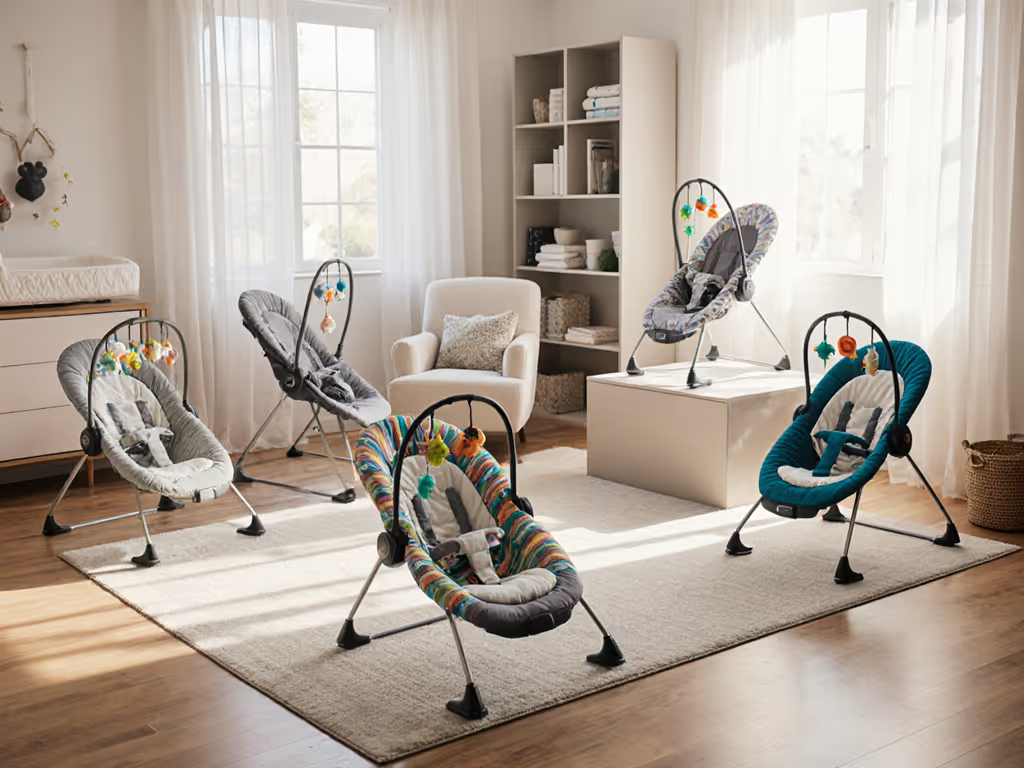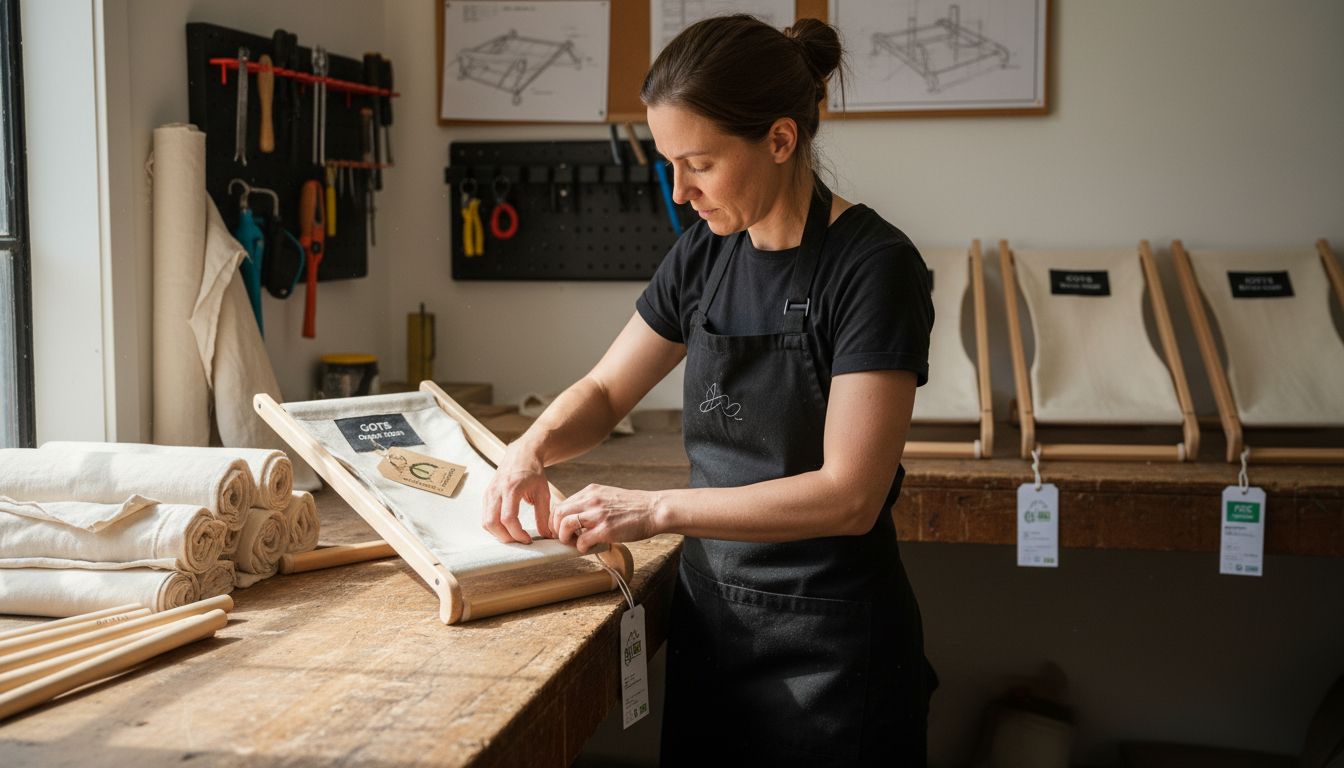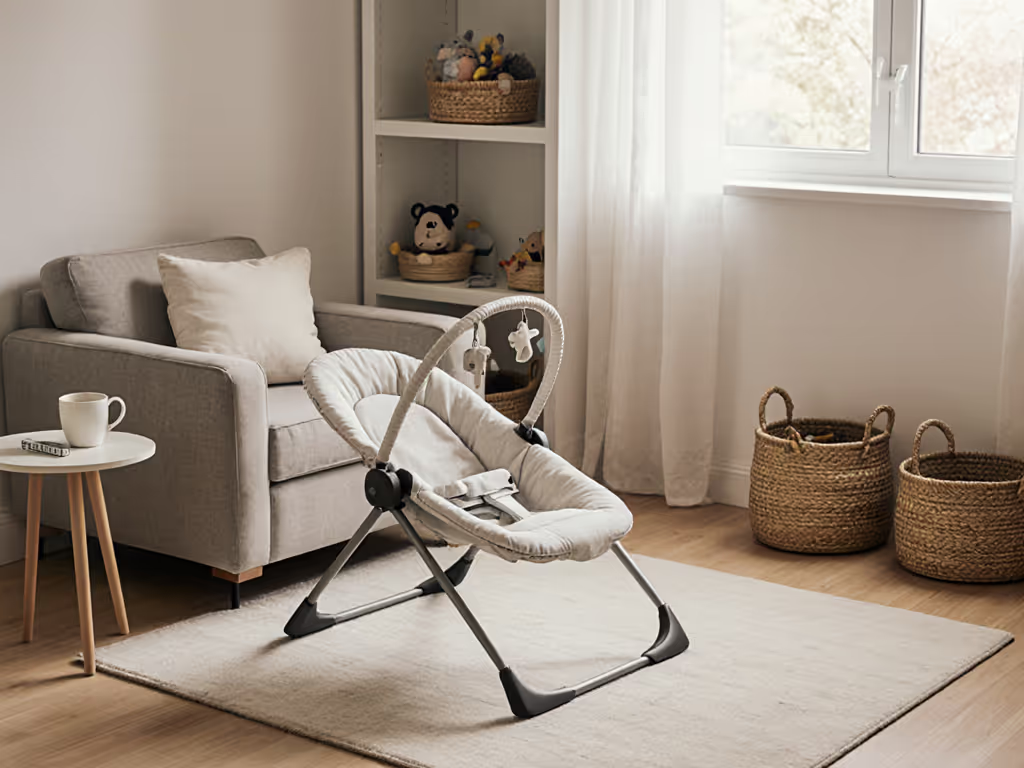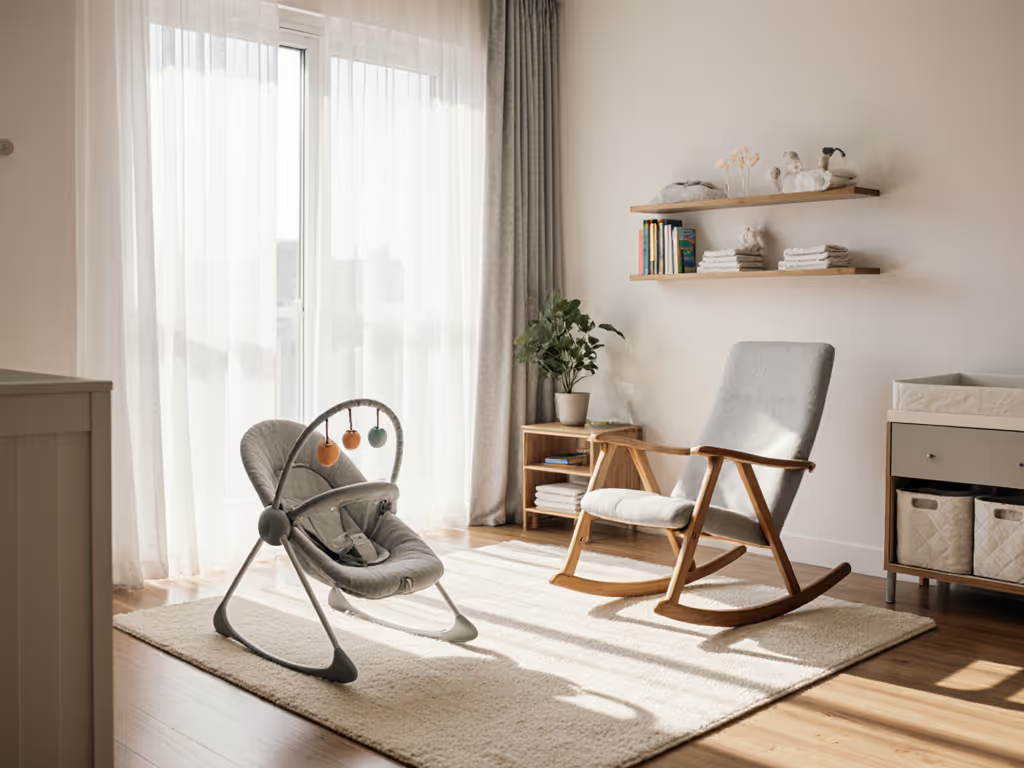
Eco-Friendly Baby Bouncers: Complete Guide for Parents

Did you know that babies can be exposed to dozens of chemicals daily through ordinary nursery products? Choosing what your little one rests in can have a real impact on their health and the planet. Eco-friendly baby bouncers are changing how families think about infant care by using non-toxic materials and earth-friendly designs. Parents now find safer comfort for babies while supporting a cleaner future right from the start.
Key Takeaways
| Point | Details |
|---|---|
| Eco-Friendly Features | Eco-friendly baby bouncers use non-toxic, organic materials, reducing chemical exposure and ensuring infant health. |
| Material Selection | Sustainable materials like organic cotton and FSC-certified wood emphasize both safety and environmental responsibility. |
| Safety Certifications | Look for certifications such as GOTS and GREENGUARD to ensure product safety and minimize environmental impact. |
| Investment for the Future | Choosing eco-friendly options not only supports immediate infant safety but also promotes sustainable consumption for long-term benefits. |
Defining Eco-Friendly Baby Bouncers
Parents seeking safe and sustainable infant equipment are increasingly turning to eco-friendly baby bouncers - innovative products designed to minimize environmental impact while prioritizing infant safety and health. These specialized bouncers go beyond traditional designs by incorporating materials and manufacturing processes that protect both babies and our planet.
At their core, eco-friendly baby bouncers are characterized by several key features that distinguish them from conventional models:
- Non-toxic materials that eliminate exposure to harmful chemicals
- Organic fabric sourced from sustainable agricultural practices
- Low-impact manufacturing processes that reduce carbon footprint
- Recyclable or biodegradable components that minimize waste
The fundamental philosophy behind these bouncers centers on creating infant products that are simultaneously gentle on delicate baby skin and kind to the environment. By selecting materials like organic cotton, responsibly sourced wood, and non-toxic padding, manufacturers can create products that meet rigorous safety standards while reducing ecological impact. These bouncers represent more than just a seating solution - they embody a holistic approach to responsible parenting that considers long-term environmental consequences.
Types of Eco-Friendly Materials Used
Designing baby bouncers with sustainable materials has become a critical focus for manufacturers committed to environmental responsibility and infant safety. The selection of eco-friendly materials goes far beyond aesthetic choices, representing a comprehensive approach to creating products that protect both children and the planet.
Several standout materials have emerged as top choices for environmentally conscious baby bouncer production:
Here's a comparison of the main materials used in eco-friendly baby bouncers:
| Material | Key Benefits | Eco Impacts |
|---|---|---|
| Organic Cotton | Soft<br>Breathable<br>Non-toxic | Pesticide-free<br>Biodegradable |
| FSC-Certified Wood | Durable<br>Safe<br>Natural look | Sustainably sourced<br>Low waste |
| Bamboo Fibers | Strong<br>Antibacterial<br>Lightweight | Rapidly renewable<br>Minimal water use |
| Natural Rubber | Flexible<br>Non-toxic<br>Soft touch | Biodegradable<br>Sustainably harvested |
| Recycled Plastics | Durable<br>Reusable<br>Flexible | Reduces landfill<br>Saves resources |
- Organic Cotton: Grown without pesticides, offering soft, chemical-free fabric
- FSC-Certified Wood: Responsibly harvested timber with minimal environmental impact
- Bamboo Fibers: Rapidly renewable material with natural antibacterial properties
- Natural Rubber: Biodegradable and sourced from sustainable plantations
- Recycled Plastics: Transforming waste materials into functional, durable components
Each material brings unique benefits to eco-friendly baby bouncers. Organic cotton, for instance, eliminates harmful chemical exposure while providing breathable comfort. FSC-certified wood frames ensure structural integrity without compromising forest ecosystems. Bamboo fibers offer exceptional durability and natural resistance to bacteria, making them an ideal choice for infant products that require frequent cleaning and handling. By thoughtfully combining these materials, manufacturers create bouncers that are not just safe for babies, but also kind to our broader environmental ecosystem.
Core Benefits for Babies, Parents, and Planet
Eco-friendly baby bouncers represent a holistic solution that delivers comprehensive advantages across multiple dimensions - protecting infant health, supporting parental peace of mind, and contributing to broader environmental sustainability. These innovative products are far more than simple seating devices, embodying a sophisticated approach to responsible child-rearing.
The benefits for babies are particularly significant:
- Reduced Chemical Exposure: Non-toxic materials protect delicate infant immune systems
- Hypoallergenic Surfaces: Minimizing risks of skin irritation and allergic reactions
- Natural Temperature Regulation: Breathable materials keeping babies comfortable
- Safe Sensory Experience: Soft, natural textures supporting developmental interactions
For parents and the broader environmental ecosystem, eco-friendly baby bouncers offer equally compelling advantages. These products provide financial long-term value through durability, reduce overall carbon footprint, and demonstrate a commitment to sustainable consumption. By choosing environmentally responsible infant products, parents actively participate in creating a healthier future - supporting responsible manufacturing practices while ensuring their child's immediate comfort and safety. The ripple effect extends beyond individual families, contributing to a more conscientious approach to product design and consumption in the children's equipment market.

Safety Standards and Recognized Certifications
Navigating the world of safety certifications for eco-friendly baby bouncers requires understanding key standards that protect infant well-being and environmental integrity. These certifications serve as critical benchmarks, ensuring that products meet rigorous requirements for material safety, manufacturing processes, and overall product quality.
Parents should look for several important certifications when selecting an eco-friendly baby bouncer:
- GOTS (Global Organic Textile Standard): Verifies organic textile production
- OEKO-TEX Standard 100: Confirms absence of harmful chemicals in textiles
- FSC (Forest Stewardship Council): Guarantees responsible wood sourcing
- GREENGUARD Gold: Certifies low chemical emissions for indoor environments
- ASTM International Safety Standards: Ensures structural integrity and safety design
These certifications do more than just provide peace of mind. They represent a comprehensive approach to infant product safety that considers chemical exposure, material sustainability, and potential long-term health impacts. By choosing products with multiple recognized certifications, parents can confidently select baby bouncers that not only protect their child's immediate safety but also contribute to a broader commitment to environmental and health-conscious manufacturing practices.
Comparing Eco-Friendly With Conventional Bouncers
The landscape of baby bouncers has dramatically transformed, with eco-friendly alternatives presenting a stark contrast to traditional models. Conventional bouncers often prioritize cost-effectiveness and mass production, while eco-friendly options focus on holistic safety, sustainability, and long-term environmental impact.
Key differences emerge across multiple critical dimensions:
- Material Composition: Conventional bouncers typically use synthetic plastics and chemically-treated fabrics, whereas eco-friendly models utilize organic, natural materials
- Chemical Exposure: Traditional bouncers may contain harmful flame retardants and volatile organic compounds (VOCs)
- Manufacturing Process: Eco-friendly bouncers employ sustainable production methods with lower carbon emissions
- Lifecycle Impact: Conventional bouncers contribute more to landfill waste, while eco-friendly versions are often biodegradable or recyclable
- Health Considerations: Natural materials in eco-friendly bouncers reduce potential skin irritation and allergic reactions
Beyond immediate product differences, the choice between conventional and eco-friendly bouncers represents a broader philosophical approach to parenting. Eco-conscious parents are increasingly recognizing that their purchasing decisions extend far beyond individual product performance, directly impacting environmental sustainability and their child's long-term health. By selecting thoughtfully designed, responsibly manufactured baby equipment, they're making a statement about the kind of world they want to create for future generations.
Buying Tips for Choosing Sustainable Options
Selecting the right eco-friendly baby bouncer requires a strategic approach that goes beyond simple aesthetic preferences. Parents must become informed consumers, carefully evaluating multiple factors to ensure they're making a responsible and safe purchase that aligns with both environmental and infant health considerations.
Critical buying considerations include:
- Certification Verification: Look for multiple recognized eco-certifications like GOTS, OEKO-TEX, and FSC
- Material Transparency: Seek detailed information about material sourcing and manufacturing processes
- Chemical-Free Guarantees: Confirm absence of harmful flame retardants and volatile organic compounds
- Durability Assessment: Choose bouncers designed for longevity to reduce overall environmental impact
- End-of-Life Potential: Consider products with recyclable or biodegradable components
Beyond technical specifications, parents should approach eco-friendly baby bouncer shopping as an investment in their child's future. This means prioritizing quality over price, understanding that sustainable products might have a higher upfront cost but deliver significant long-term value. By asking manufacturers tough questions about their environmental practices, researching product backgrounds, and staying informed about emerging sustainable technologies, parents can make purchases that reflect their commitment to both infant safety and environmental responsibility.
Discover the Perfect Eco-Friendly Baby Bouncer for Your Home and Baby
Choosing an eco-friendly baby bouncer means prioritizing your infant's safety and comfort while making a positive impact on the planet. This article highlights the challenges parents face when searching for non-toxic, durable, and sustainable baby gear that fits small living spaces and busy lifestyles. Many parents worry about chemical exposure, material transparency, and finding models that are both space-efficient and easy to clean. At the heart of these concerns is the desire to provide a healthy, nurturing environment for their child without compromising on practicality.
At Bouncer Lab, we understand these goals and offer detailed reviews and comparisons to help you navigate the complex world of infant bouncers. Whether you want to explore eco-friendly models built with organic cotton, sustainable wood, or recycled materials, or you need space-saving designs that fit seamlessly into small homes, our comprehensive guides cover all the essentials. We bring you the latest in safety standards and user-friendly features so you can make informed decisions with confidence.
Ready to find a baby bouncer that combines safety, sustainability, and space-saving design? Visit Bouncer Lab now to explore our insightful reviews and expert advice. Let us help you choose the ideal eco-friendly baby bouncer that supports your parenting values and lifestyle today.
Frequently Asked Questions
What are eco-friendly baby bouncers?
Eco-friendly baby bouncers are infant seating products designed with sustainable materials and manufacturing processes that minimize environmental impact while ensuring safety and health for babies.
What materials are commonly used in eco-friendly baby bouncers?
Common materials include organic cotton, FSC-certified wood, bamboo fibers, natural rubber, and recycled plastics, all chosen for their sustainability and safety benefits.
How do eco-friendly baby bouncers differ from conventional ones?
Eco-friendly baby bouncers typically use natural, non-toxic materials and sustainable manufacturing processes, whereas conventional bouncers often involve synthetic plastics and harmful chemicals, leading to greater environmental impact and potential health risks for infants.
What certifications should I look for when purchasing an eco-friendly baby bouncer?
Important certifications to consider include GOTS (Global Organic Textile Standard), OEKO-TEX Standard 100, FSC (Forest Stewardship Council), GREENGUARD Gold, and ASTM International Safety Standards, which ensure product safety, sustainability, and low chemical emissions.




